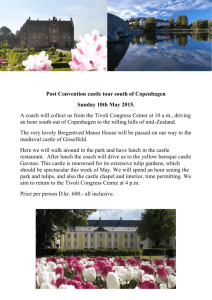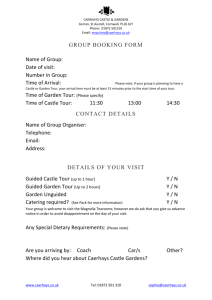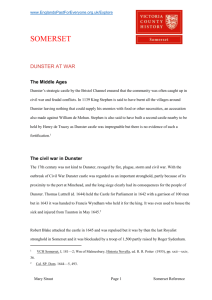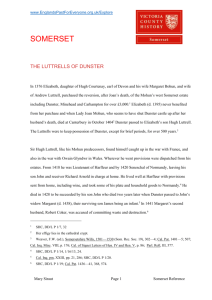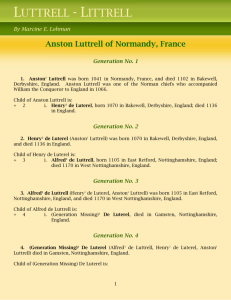George-ous Views, Castle Drogo
advertisement
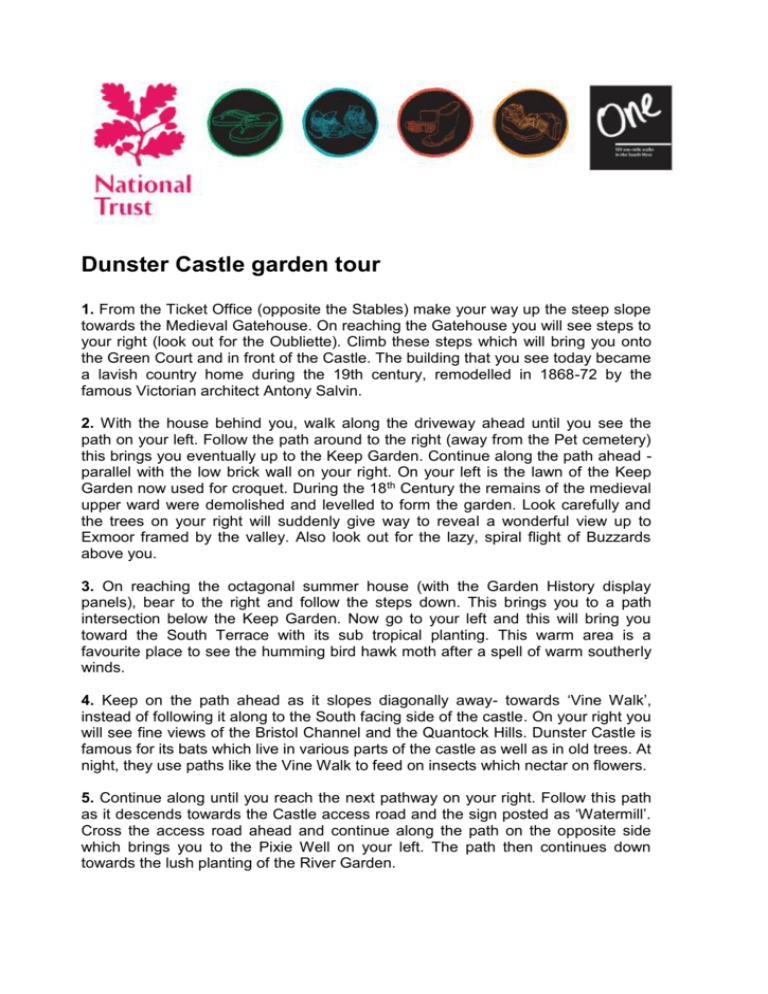
Dunster Castle garden tour 1. From the Ticket Office (opposite the Stables) make your way up the steep slope towards the Medieval Gatehouse. On reaching the Gatehouse you will see steps to your right (look out for the Oubliette). Climb these steps which will bring you onto the Green Court and in front of the Castle. The building that you see today became a lavish country home during the 19th century, remodelled in 1868-72 by the famous Victorian architect Antony Salvin. 2. With the house behind you, walk along the driveway ahead until you see the path on your left. Follow the path around to the right (away from the Pet cemetery) this brings you eventually up to the Keep Garden. Continue along the path ahead parallel with the low brick wall on your right. On your left is the lawn of the Keep Garden now used for croquet. During the 18th Century the remains of the medieval upper ward were demolished and levelled to form the garden. Look carefully and the trees on your right will suddenly give way to reveal a wonderful view up to Exmoor framed by the valley. Also look out for the lazy, spiral flight of Buzzards above you. 3. On reaching the octagonal summer house (with the Garden History display panels), bear to the right and follow the steps down. This brings you to a path intersection below the Keep Garden. Now go to your left and this will bring you toward the South Terrace with its sub tropical planting. This warm area is a favourite place to see the humming bird hawk moth after a spell of warm southerly winds. 4. Keep on the path ahead as it slopes diagonally away- towards ‘Vine Walk’, instead of following it along to the South facing side of the castle. On your right you will see fine views of the Bristol Channel and the Quantock Hills. Dunster Castle is famous for its bats which live in various parts of the castle as well as in old trees. At night, they use paths like the Vine Walk to feed on insects which nectar on flowers. 5. Continue along until you reach the next pathway on your right. Follow this path as it descends towards the Castle access road and the sign posted as ‘Watermill’. Cross the access road ahead and continue along the path on the opposite side which brings you to the Pixie Well on your left. The path then continues down towards the lush planting of the River Garden. 6. The path then brings you onto the road that leads toward Lawn’s bridge. Turn right and follow the road ahead then take the next right, entering the ‘Mill Walk’ through the pair of open iron gates. This is a fantastic place to see dragonflies like the metallic blue, banded demoiselle. 7. Follow the path ahead in the direction of the Watermill and look out for Alys Luttrell’s unusual ‘hankerchief’ tree on your left. The path runs parallel with the river and will eventually bring you to Lovers’ bridge on your left. 8. Follow the path over Lovers’ bridge (why not try out the stone seats in the parapets made for two from which the bridge takes its name). 9. Continue ahead along the path until it winds its way to Marshall’s bridge. Cross over the bridge and the path brings you to the rustic log play area. Look out for the Giant Redwood trees. Follow the path from the rustic log play area until it brings you back toward the ‘Mill Walk’. 10. Bear right on the Mill Walk and continue toward the iron gates you entered through earlier. Then turn left and continue up the road back towards the main drive that passes our visitor car park. 11. This road brings you to a small timber octagonal building on the left with the visitor car park to the right. Turn left onto the main access drive way at this point and follow it back up toward the Castle. Where the access drive divides in two bear to the right and follow it back round to the 17 th Century Stables and the Ticket Office were you first started. Why not take time to explore the stables and visit the National Trust shop. Features From castle to country house Dunster Castle has stood on this site for nearly 1000 years, repeatedly altered and adapted to suit changing needs and tastes. In 1617 William Arnold began building a new house for George Luttrell within the Castle’s medieval fortifications – which were largely demolished after the Parliamentary army captured it in 1646. The lavish interiors Francis Luttrell created in the 1680s plunged the family into debt. Between 1868 and 1872, architect, Anthony Salvin, remodelled the house for George Fownes Luttrell. He added the great towers to make it look more medieval and castle-like, but with all the comforts of a Victorian country house. Views The Keep Garden boasts panoramic views of the surrounding landscape. Specially sited benches face four key views. Looking east are the Quantock Hills and the old deer-park. On a clear day you can spot Hinkley Point and even Western-SuperMare. Looking north-east, the Tenants Hall has a fantastic backdrop of the south coast of Wales. To the south-west, Dunkery Beacon,1705ft (519m) above sea level, is believed to have inspired the hymn ‘All things bright and beautiful’. To the west and north are Minehead Harbour, Grabbist Hill, Conygar Hill and Conygar Tower; a folly built for Henry Fownes Luttrell in 1775. River Gardens Described as ‘a plantsman’s paradise’, Dunster Castle’s River Gardens offer a sheltered climate, enabling sub-tropical plants to thrive. They provide ideal conditions for rhododendrons, azaleas, Giant Redwood, Western Red Cedar and Douglas Fir. Alys Luttrell, who lived in the Castle until she died in 1974, introduced most of the shrubs and trees you see today. One notable specimen is the Handkerchief Tree. The River Avill winds its way through the gardens beneath three bridges. Lawns’ Bridge and Lovers’ Bridge were both commissioned by Henry Fownes Luttrell in the late 18th Century. Marshall’s Bridge, a modern metal structure, stands between them.





